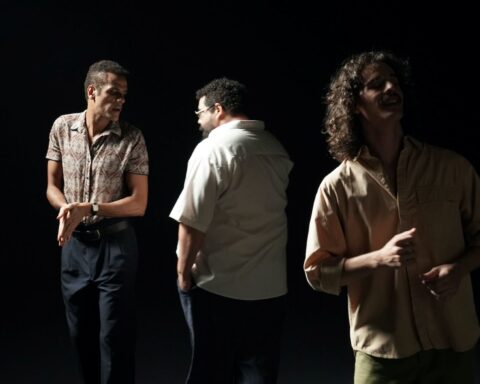A winking post-modern concoction that has, over its very short career, inspired reams of passionate critical response, Incident at Loch Ness is ostensibly about a spectacularly troubled production, mounted by the German documentary (and occasionally fiction film) director Warner Herzog. It finds the indomitable auteur—famous throughout his career for his forcible, occasionally unscrupulous mastery of exotic, heretofore inaccessible subject matter—in search of the Loch’s most famous hypothetical resident.
Complicating matters is the presence of a second film crew, headed by the well-known cinematographer John Bailey. They are making an intimate verité documentary about Herzog’s curious new existence as a Hollywood homebody. Apparently, when he’s not proudly displaying his collection of poison-tip arrows, the director hosts dinner parties attended by such prolific public-domain weirdos as Jeff Goldblum, Ricky Jay and, fleetingly, Crispin Glover.
It is Bailey’s film, “Herzog in Wonderland” that we are supposedly watching, in some hastily re-constituted form. (The opening crawl directly references The Blair Witch Project, the first sign that something’s up.) Herzog’s Loch Ness movie, the making of which unfolds before our eyes and through Bailey’s increasingly curious camera lens, has its mounting share of bizarre problems. The consequences of these problems end up hampering both shoots beyond repair. Somewhere along the line, two people disappear, having been eaten, quite possibly, by the Loch Ness Monster.
In the film, Herzog describes his doomed project’s need for a “crypto-zoologist,” somebody who is both, in his words, “credible” and “obsessed.” The joke, of course, is that Herzog need look no further than a mirror: few filmmakers have proven to be as adept at blending balls-out lunacy and humanistic gravity. Herzog’s line blurring has always been in the service of what he calls in Incident at Loch Ness the “ecstatic truth”—a deep, transcendent authenticity that resonates well beyond mere fact.
Herzog’s striving explains his involvement in this initially deceptive and relentlessly clever meta-movie. It blows its faux-doc cover somewhere after Nessie’s first, surprisingly convincing, on-screen appearance. Nevertheless, Incident at Loch Ness stands as an apt and rewarding clarion call for the “hybrid,” one of the hippest and most challenging forms in contemporary filmmaking.
The current omnipresence of mockumentaries, from the gently eccentric spoofs of Christopher Guest to the much-reviled American feature The September Tapes, which recasts The Blair Witch Project as an overseas soldier’s video diary and substitutes Osama Bin Laden as the unseen malevolent force, has brought legitimacy to a disreputable genre that dates back as far as Orson Welles’ 1938 broadcast of The War of the Worlds. Welles’ valedictory F is For Fake (1973)—which places the War of the Worlds hoax among its inventory of significant forgeries—is, perhaps, the keynote film of Cinematheque Ontario’s Fall 2004 “Hybrid” presentations.
The programme spotlights films that curator and POV editor, Peter Wintonick, cryptically describes as “defying the death of definition.” On that note, hybrids should not be characterized strictly as mockumentaries—rather, they are films involved in blurring the line not only between fact and fiction, but also across genres. They are generally predicated on contradiction of both structure and content.
Wintonick, whose own credits as a documentary filmmaker include the acclaimed Noam Chomsky profile Manufacturing Consent, is also a former collaborator of Peter Watkins. The British-born Watkins’ 1966 Oscar winning short The War Game, which hypothesized about the effects of a nuclear strike at the height of the Cold War, is arguably among the greatest of all hybrid films. Its clinical assemblage of cold statistics and probabilities are underpinned by a fervid, terrified humanism. Banned for a time in England, its power to unsettle endures, and is achieved not in spite of, but rather because of, its employment of rigidly informational, apparently conventional, documentary techniques.
Hybrids are defined— as much as they can be— by their desire to push and play with form. Wintonick explains that his goal for the Cinematheque series was “to push hybrids— although a cursory investigation of film history will show they have always been here, and that they have always defined the new, the innovative in cinema.” He thus rejects the idea that, in this year of Fahrenheit 9/11 and “Swift Boat Veterans For Truth,” the latter commodity has proven any slipperier than usual, in the hands of filmmakers or the media at large.
“Truth,” he says, “has never had anything to do with documentary. But the ‘fact’ that the mainstream curtain of lies has been raised for all to watch, and comment upon, and be aware of, means that the general scepticism that the populace has always with media, law, and government now turns out to be ‘true.’ The lies,” he continues, “that Michael Moore allegedly tells—distortions, editing licence—according to those who critique his methods in anti-Moore books, websites and films now being distributed, can only raise the question: can our propaganda ever be as good as theirs?”
In answering his own challenging query, Wintonick is less than optimistic: “I think not. Even when humour is our new main weapon, the real hard steel weapons extending war and capital around the globe, and the hard-as-steel “mass”(ive) media as voiced by subservient stenographers to power are still in the wrong hands, or in anyone’s hands.” Against this overwhelming crush of dubiously stated opinion, then, the hybrid film—whether or not it engages in explicit politicising, as Michael Moore’s populist video collages most certainly do— would seem to be an exquisite weapon: a means of turning disinformation against itself.
The objective of a hybrid film like Incident at Loch Ness, says Wintonick, is to “push the idea of distrust in the image…to overthrow boredom, earnestness and complacent somatic in active media.” The entreaty it offers to filmgoers, even those who perceive themselves as case hardened and genre-savvy, is to question what they are watching. Wintonick’s programme implores the viewer not to accept that any film billing itself as documentary, and bearing the aesthetic hallmarks of the form—like talking heads, natural lighting or source sound—is necessarily a work of non-fiction.
That Incident at Loch Ness is directed and written by Zak Penn, a self-admitted Hollywood hand whose scripts include such special-effects abetted blockbusters as X2: X-Men United and Behind Enemy Lines, speaks to the increasing number of films whose untrustworthiness is, in fact, part of their design. Penn gleefully contributes to the untrustworthiness of his own film by appearing as himself, or rather as “Zak Penn,” an egomaniacal La-la land jerk.
Penn’s hybrid proved to be too much for Leah McLaren, the short-fused reviewer from The Globe and Mail, who was “so irritated (she) could have ripped the film from its projector and chewed it to a chemical pulp” after realising too late that she was watching a not-doc. The horror! McLaren’s anger speaks to the encroaching ingenuousness on the part of audiences that Wintonick describes and that Penn—whose lucrative career catering to the multiplex masses makes him a perfect covert agent—obviously hoped to skewer.
The masterstroke, of course, was casting Herzog as its hero. Penn’s frenzied, sub-Peter Benchley climax gains immeasurably from featuring (in the obsessed Ahab/Quint role) the man who, for Fitzcaraldo (and its accompanying doc, Burden of Dreams) really dragged a steamship over a mountain range for the simple purpose of photographing it. Obsessed but credible, even when he’s firing a flare gun into the water from the deck of a sinking ship? You bet.
Herzog’s own Little Dieter Needs to Fly (1997) is screening as part of the Cinematheque’s line-up, and may be the filmmaker’s most labyrinthine—and perhaps, paradoxically, most empathetic —creation. On one level, it’s a straight documentary about Dieter Dengler, a German-born American air force pilot who was imprisoned in Laos during the Vietnam War. The film is preoccupied with the details of his incarceration and his remarkable escape through the jungle, which he barely survived.
Dengler’s own accounts of these events are gripping enough, but Herzog’s pursuit of the “ecstatic truth” he describes in Incident at Loch Ness may be what inspires him to stage re-enactments of his protagonist’s ordeal. That these re-enactments are filmed on actual Laotian locations, and star Dengler himself—stripped, trussed, and forcibly marched over the same terrain that nearly claimed his life thirty years earlier— creates a sense of bewilderment tinged by palpable discomfort. What catharsis could this haunted man seek by revisiting the site of his most painful experiences? And what could Herzog’s motives be in arranging such a tortuous reconciliation?
They are likely the same motives that moved him to allegedly “suggest” certain images to his subject, to give the latter’s stories a more mythic—or is that Herzogian?—tinge. Dengler’s vivid, poetic recollection of a bear that followed him throughout his escape is his own, but a subsequent sequence, in which Dengler explains that a tank of jellyfish represents his personal vision of Death, is by contrast an instance of coercion. Herzog has finessed words into Dengler’s mouth, and thus manufactured a symbol—the hovering, malevolent jellyfish as a harbinger of demise—that suits his personal vision.
The suggestion that Dengler is obsessive-compulsive regarding the opening and closing of doors is similarly fabricated—it’s a bit of business that the director simply thought to “fit” with other aspects of Dengler’s post-traumatic condition. Dengler has no problem explaining the door-related anxiety, however, and is even convincing as he does so.
Inventions both, these details nevertheless ring true within the mood and texture of the film. Rather than detracting from our understanding of Dengler, through some strange alchemy, they enhance it. The point is that Dengler’s truth remains stranger than Herzog’s minor fictions. And somehow, the two fit together; the film goes from a simple act of recording to a veritable collaboration. It’s the trust between an artist with designs on explicating the human condition, and a subject who realizes that his personal demons have universal undertones.
This trust is not apparent—nor should it be—in the films of Emile de Antonio, two of which have been selected for inclusion in the Cinematheque series. Richard Nixon was obviously not a willing collaborator on Milhouse: A White Comedy (1971) an incendiary but long-forgotten slice of political agitprop that has enjoyed a critical re-evaluation in the wake of Fahrenheit 9/11. The film is a scathing broadside against the Nixon administration, a spectacular contradiction of the President’s own hopeful assertion, years before its release, that the media wouldn’t have him to kick around anymore. How wrong he was: _Milhouse_ is the equivalent of a hard roundhouse to the face.
What binds de Antonio to Michael Moore is their shared disdain for authorial objectivity: although Milhouse’s eponymous villain does a fair job incriminating himself in a series of energetically assembled television clips, the film’s narration openly conveys the director’s disgust for his subject. The thesis of Oliver Stone’s comparatively apologist Nixon —that the man was more a pathetic, pathologically driven attention seeker than a scheming emissary of evil—is given no consideration here. It’s character assassination all the way. Three decades of hindsight haven’t altered the picture’s potency, although the argument can be made (as it can against Fahrenheit 9/11) that cheap shots, however satisfying, carry less weight than skilfully wrought observation.
The other de Antonio film being shown, In the King of Prussia, is similarly problematic. An account of the “Plowshares Eight” protest, in which a group of religious radicals invaded and vandalized a Pennsylvania factory involved in the production of nuclear warheads, it casts the real-life defendants as themselves, and then re-enacts their trials with actors—including Martin Sheen—as the other courtroom participants. Given de Antonio’s anti-establishment leanings, it’s no surprise that the film makes a case for the defence.
De Antonio’s fiercely one-sided cinema is less subtle than Watkins’ The War Game. But as Wintonick explains, true impartiality is rarely the aim—and even less frequently the by-product of supposedly objective documentaries, much less this trickier sub-breed of hybrids. “In any State of the Documentary Address,” he says, referring back to the earlier question of timeliness with regards to Penn’s film and his own Cinematheque Ontario programme,” I would always question the state of address in documentary, i.e. for whom the doc tolls. Or trolls… Who is it made for, and from whose pointed view voice and vision? The filmmakers? The funding agent? The public? The power elite?” In the case of the crusading leftist de Antonio, the doc trolls for those its maker sees as marginalized, and he doesn’t mind hitting below the belt in an effort to even the odds.
The controversy engendered by the muckraking works of de Antonio, Moore, and Watkins spills over into the political arena. But there are other examples of hybrid films that, like Little Dieter Needs to Fly and Incident and Loch Ness,set their sights on altering cinematic perception, rather than social commentary. And they do so not by widening their focus, but by narrowing it down to the seemingly familiar and grounded territory of the biopic.
One such film (and another Cinematheque selection) is Jim McBride’s David Holzman’s Diary (1967.) A reaction to the verité revolution of the 1960s, which saw filmmakers like the Maysles brothers, D.A. Pennebaker, Frederick Wiseman, and Canada’s Allan King redefine documentary with their pared down, strictly observational approach, the film is a convincingly uneventful self-portrait of the aimlessly striving and existentially preoccupied artist David Holzman.
Except that “David Holzman” is no more real than the Loch Ness Monster. He’s actually actor Kit Carlson, and his personal odyssey is really a painstaking satire of the first-person film diary. The film was made on the cheap, which explains its naturalistic look and feel, but its violation of the verité ethos is profound. If observational filmmaking is not to be trusted (and banal observational filmmaking at that) it implies, then the notion of an absolute truth in cinema has to be considered a fantasy. (Wintonick’s programme notes include D.A. Pennebaker’s bemused admonishment to McBride: “you’ve killed cinema verité. No more truth movies.”)
A more contemporary example of Holzman-esque identity fraud, authored by a filmmaker whose ability to perform sleight of hand on a grand scale would earn him untold millions and an Oscar, is Peter Jackson’s Forgotten Silver (1997). Mounted for New Zealand television in the interlude between the director’s breakthrough Heavenly Creatures and his subsequent mainstream canonization as the 21st Century George Lucas, Forgotten Silver is a loving tribute to a national hero, the pioneering filmmaker Colin McKenzie. According to Jackson’s film homage, McKenzie invented the first mechanized camera and came up with the idea for the close-up. Unfortunately, McKenzie didn’t exist. He, and his time worn silent masterpieces (including a pretty steamy Salome) are utter fabrications, despite onscreen talking head Leonard Maltin’s earnest pleadings to the contrary. (For the record, this appearance is likely the coolest thing the notably straight-arrow Maltin has ever done.)
What links Forgotten Silver, which is really just a brilliantly made mockumentary, to the true hybrid film tradition, was the response of the people who saw it. Like Orson Welles before him with The War of the Worlds broadcast, Jackson managed to convince the masses that they had been witness to the truth. The station that broadcast the film was deluged with phone calls, alternately overjoyed and indignant, asking why it had taken so long for McKenzie to be rediscovered.
As a gleefully self-described charlatan, Welles would have probably enjoyed Forgotten Silver, an out-and-out fake that revealed a greater truth: people want to believe in heroes, and in the transcendence of great and pioneering art. He might have even included the New Zealanders’ impassioned reactions in F is For Fake. Welles’ film pulls the curtain back on a vast array of convincing and controversial historical forgeries, and furthers the disturbing notion that fakes can, in their own way, equal or even surpass the real thing. If a copy of a Picasso is as beautiful as the real thing, to the point where an art historian can’t honestly tell the difference, than aren’t both masterpieces? And if not, then who makes that decision? The author? The critic? The audience who would not otherwise know the difference?
Ultimately and inevitably, F is For Fake reveals—and revels—in its own playful dishonesty. Wintonick sees this as a happy, and vital contradiction. “To lie,” he says, “you have to be honest, which is what the magician Welles teaches us in F is For Fake. But the subject matter in that film, forgery, is also an analogue to what we documentarians—broadcasters, journalists—do all the time. But usually we are less honest, and less talented, cinematographically speaking. This is what fiction makers can teach us.”
Now ain’t that the (ecstatic) truth?










